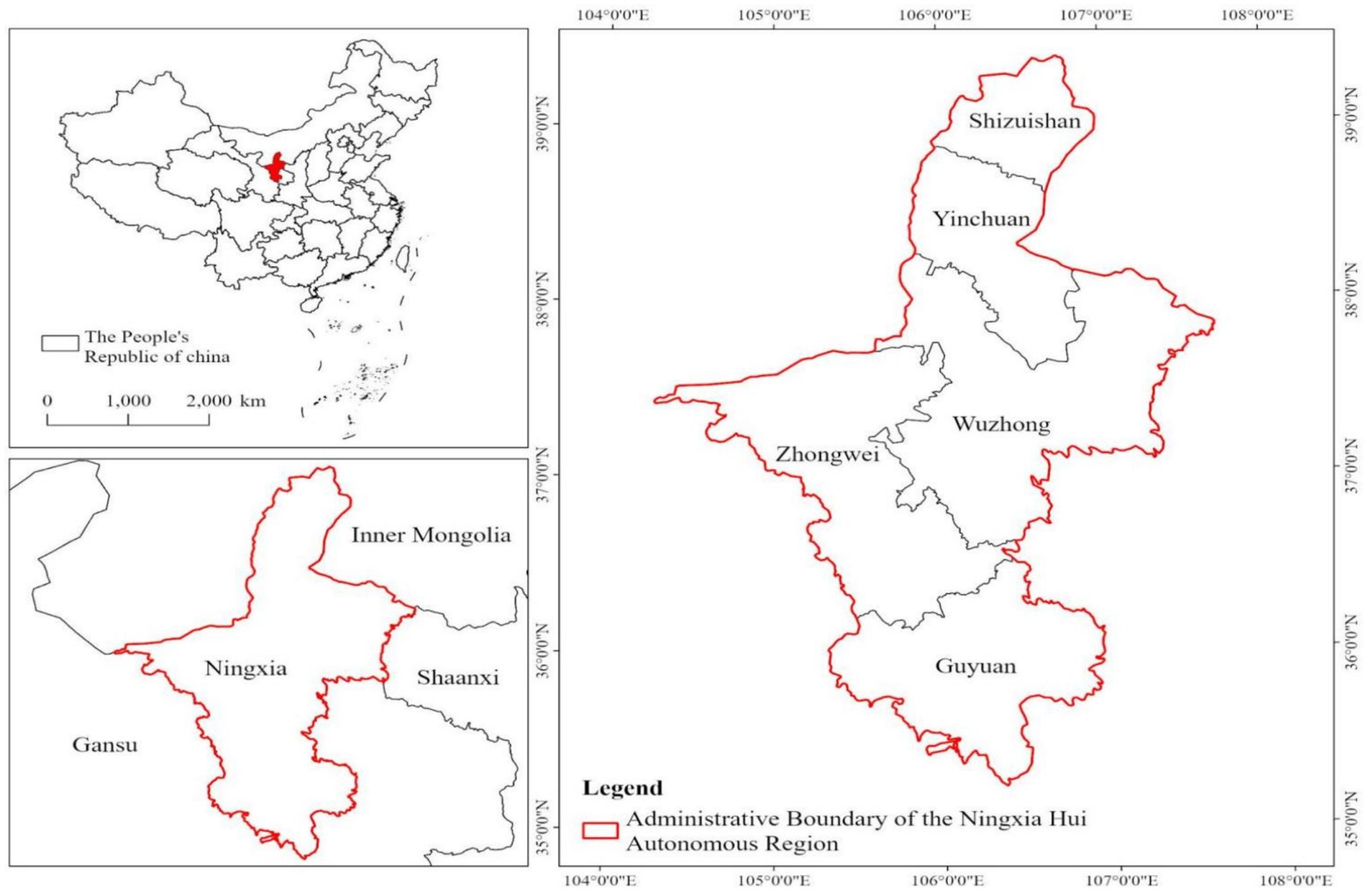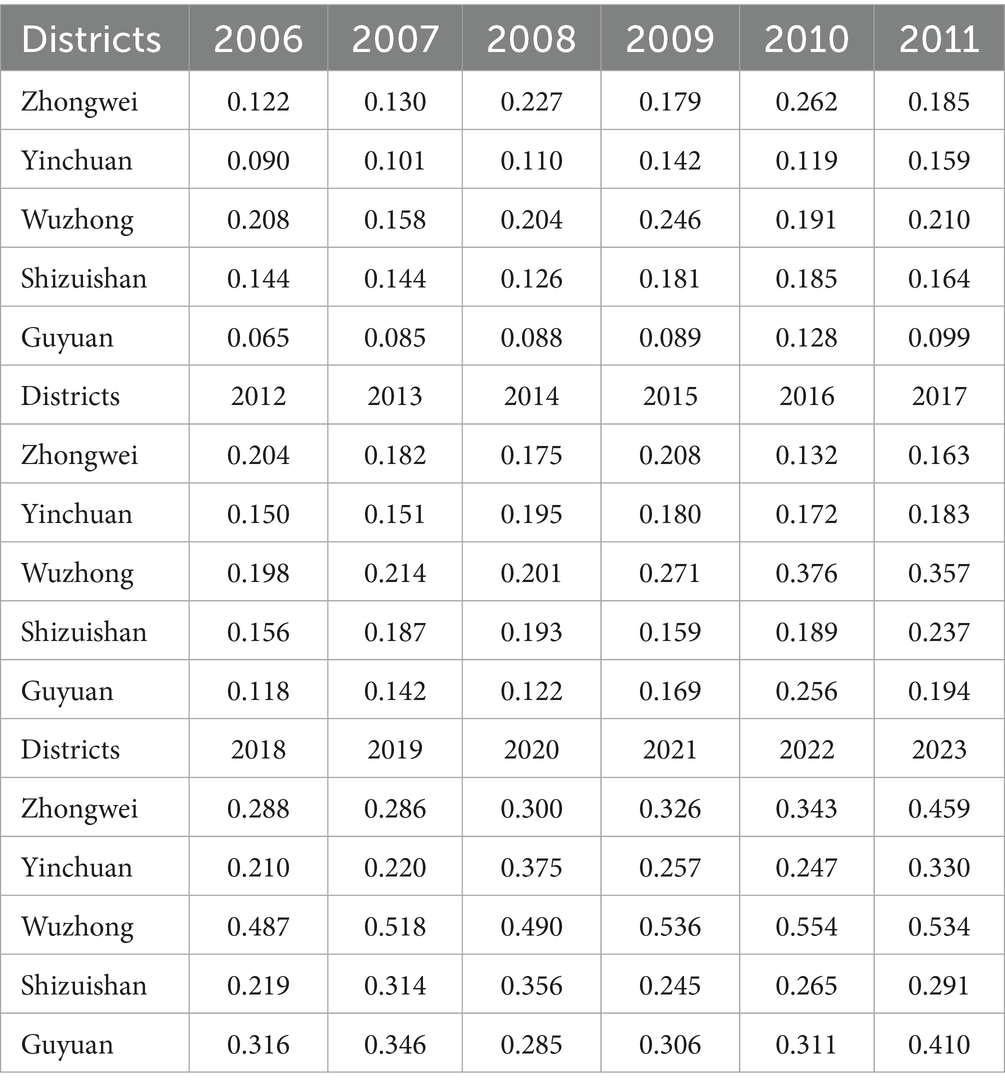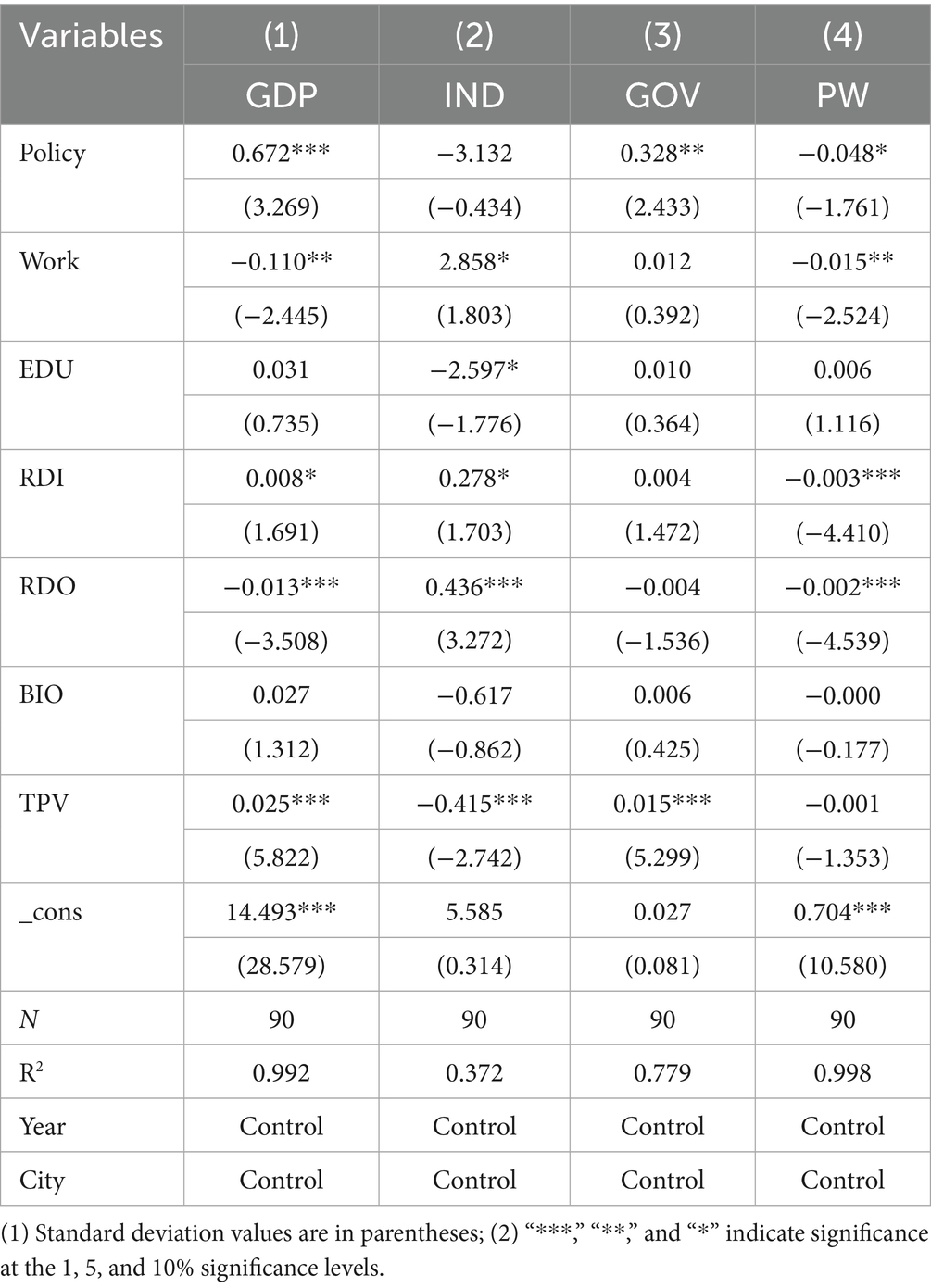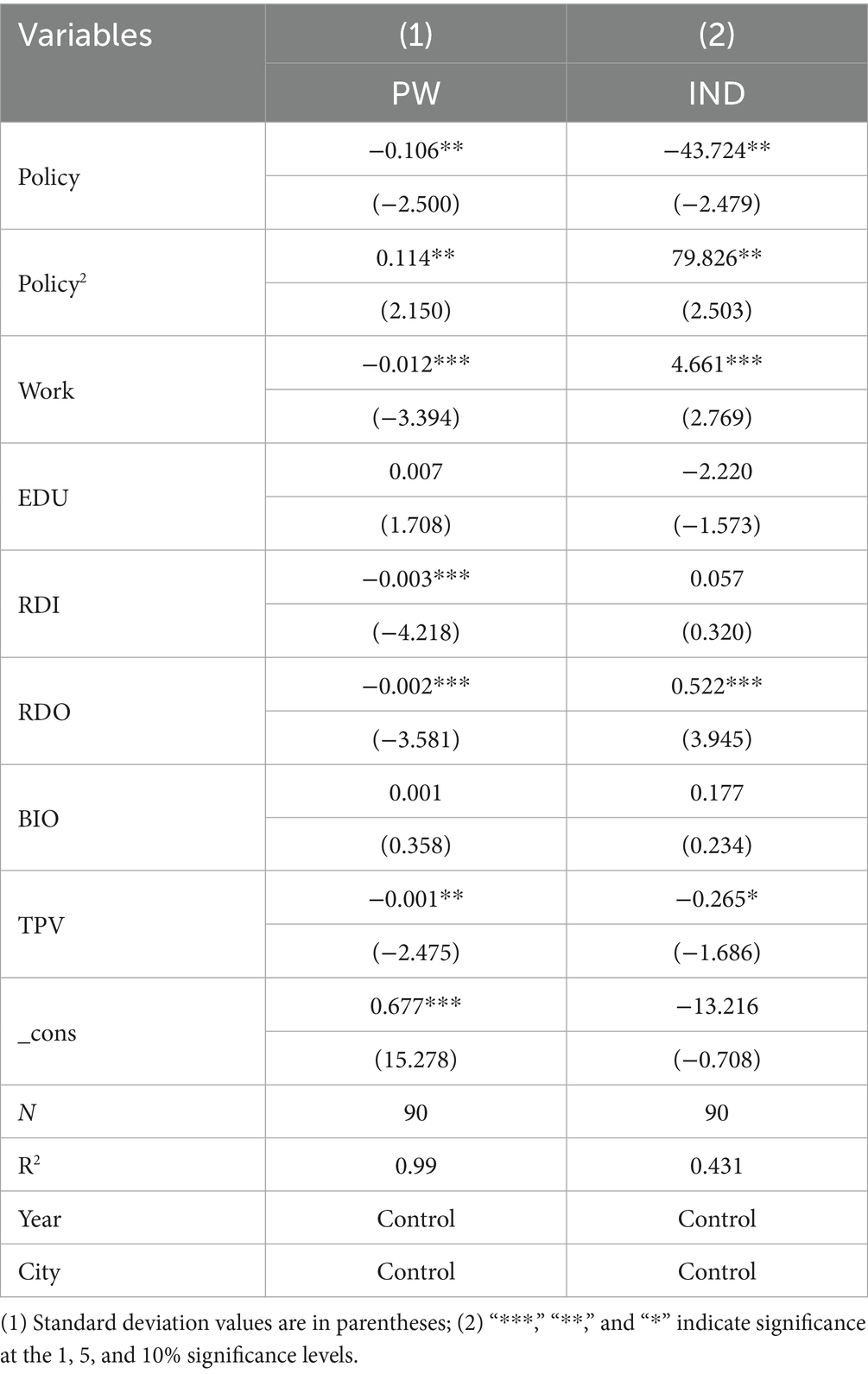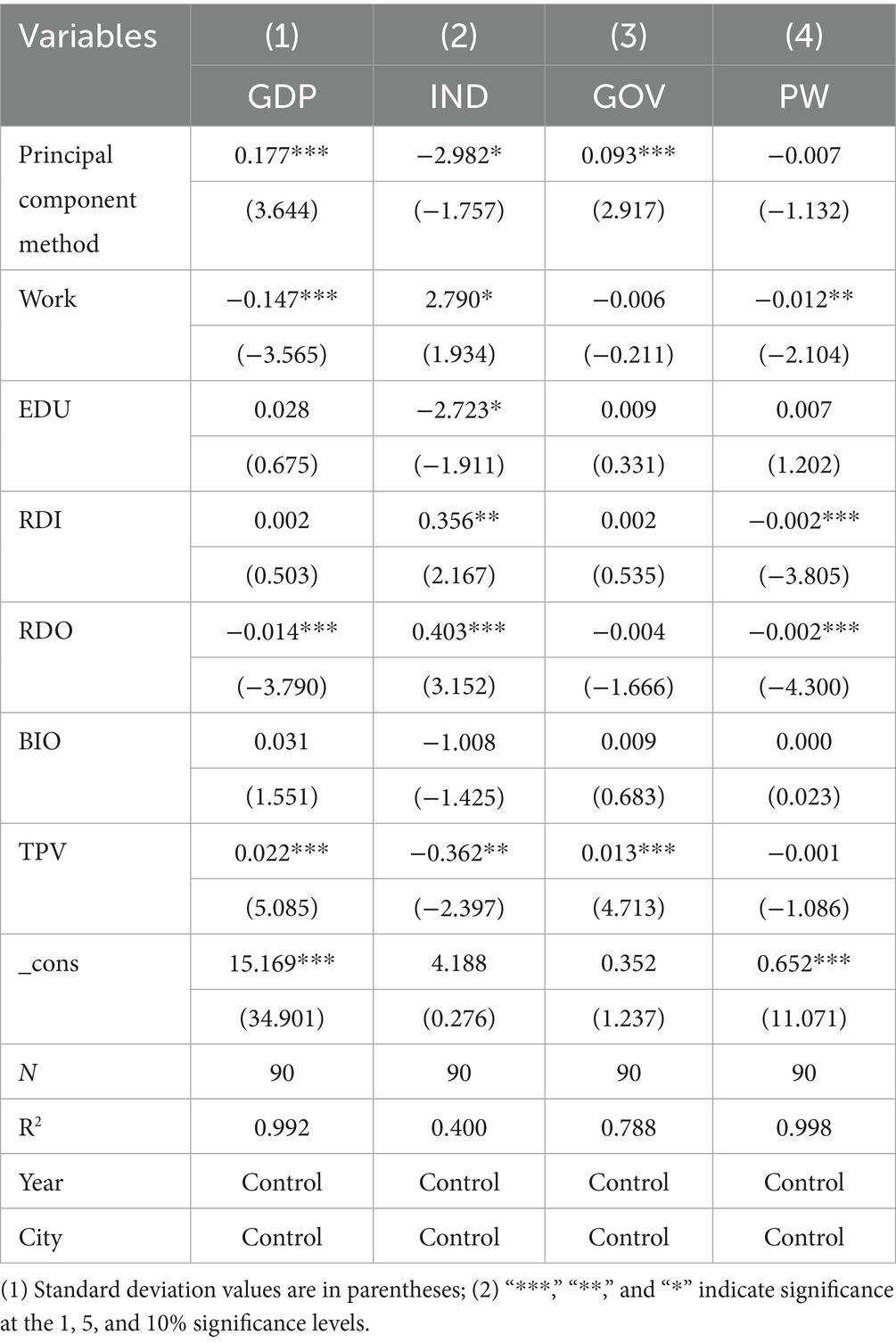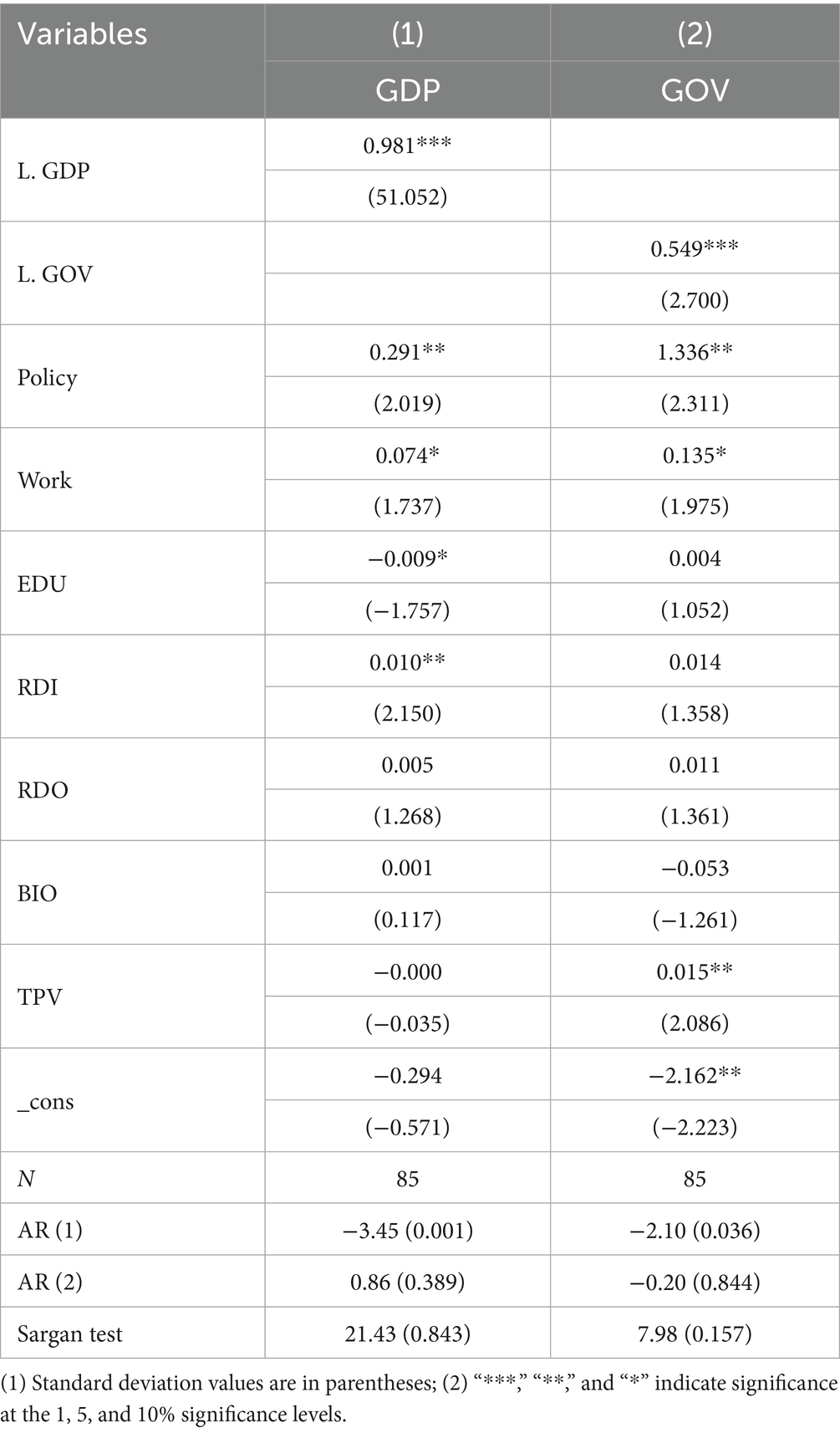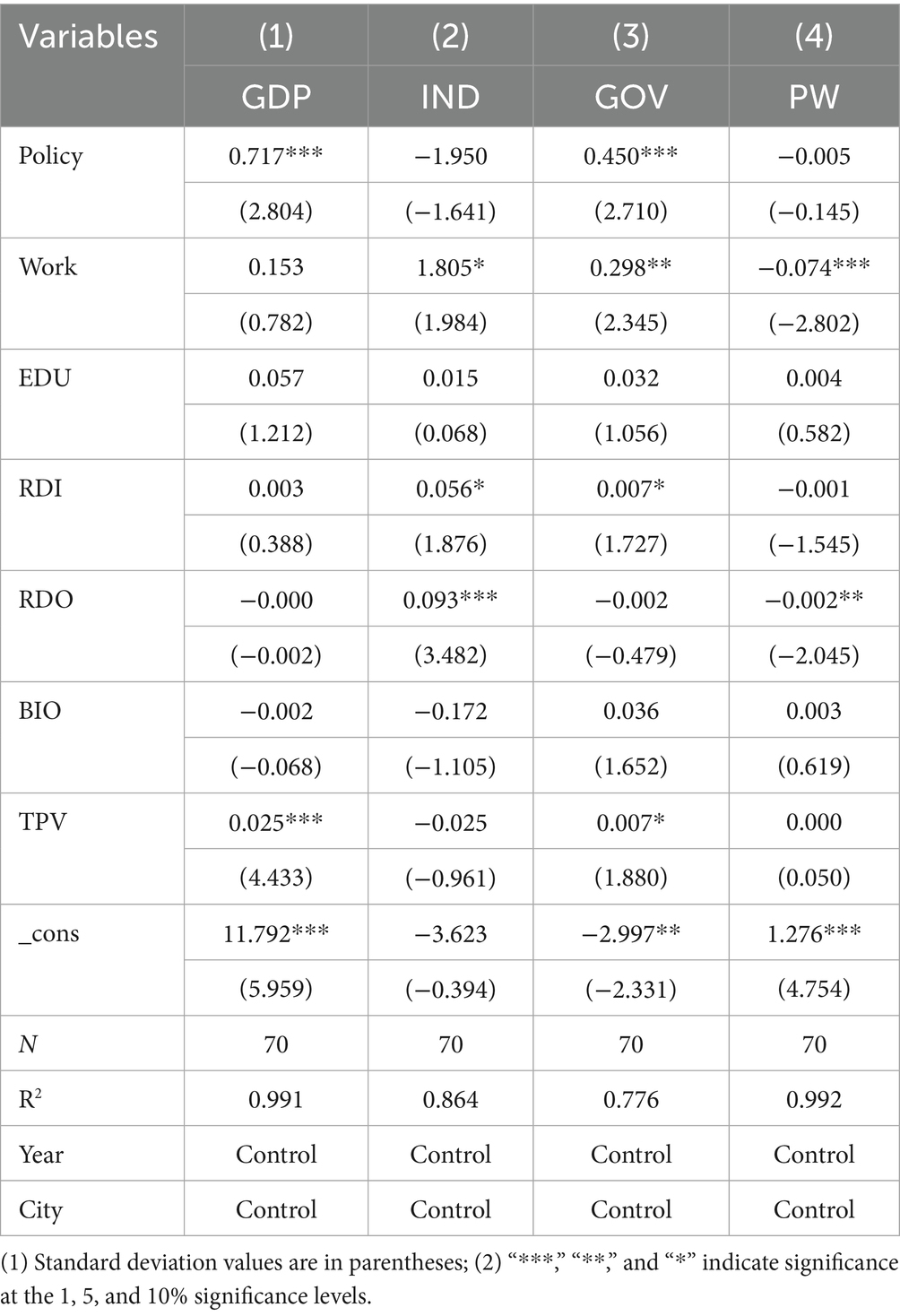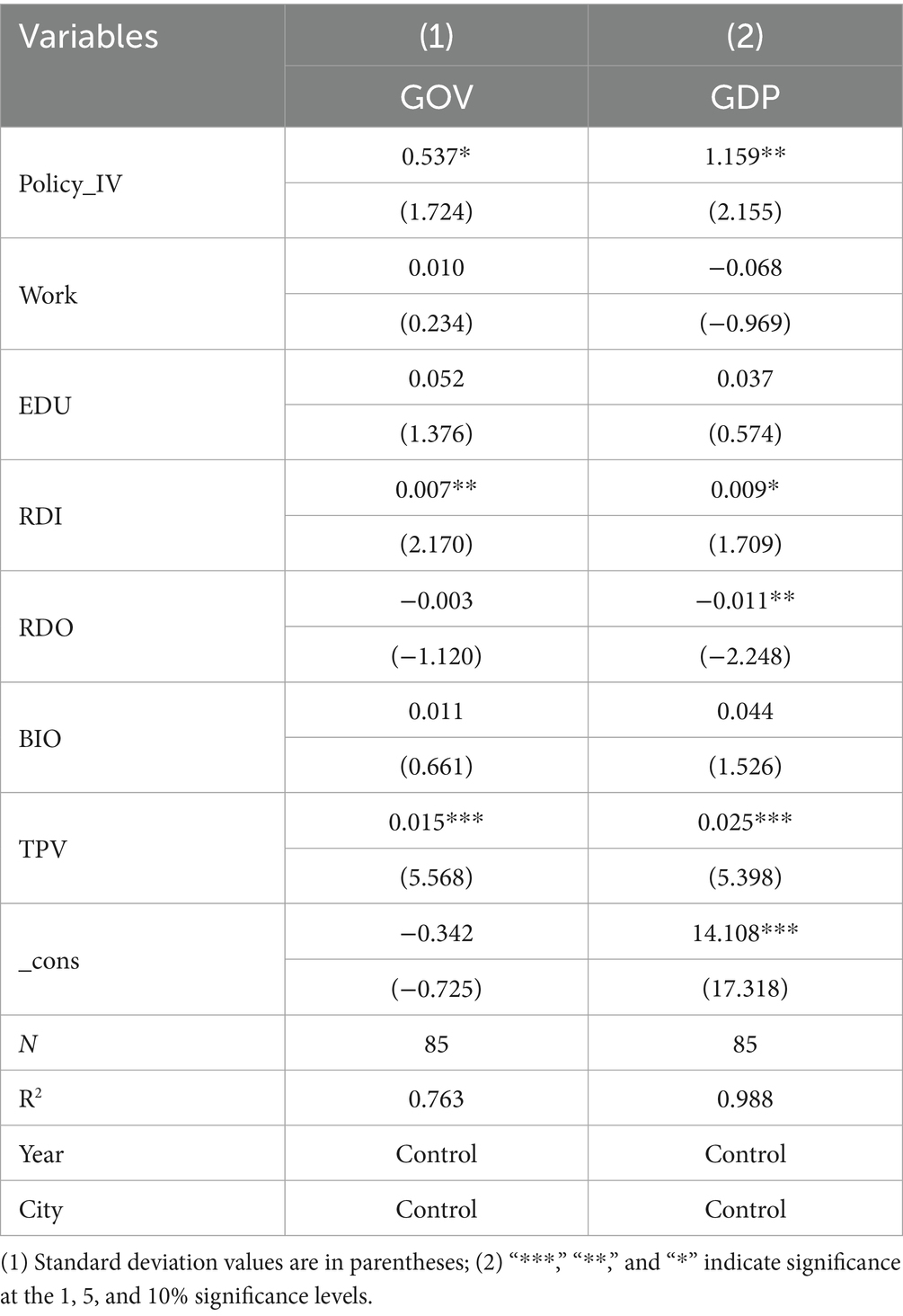- Digital Water Conservancy Innovation Team, Water Engineering Research Institute, Ningxia Hui Autonomous Region Water Conservancy Science Research Institute, Yinchuan, China
With the economy’s and society’s rapid development, reservoir construction has gradually become an essential infrastructure for water resource regulation, flood control and disaster reduction, and power generation. However, involuntary migration is an increasingly prominent global challenge, presenting a common challenge worldwide. Ningxia Hui Autonomous Region is located in the northwest of China, in the upper and middle reaches of the Yellow River basin, and is a typical arid and rainless area. To improve the uneven spatial and temporal distribution of water resources and ensure regional economic and social development, Ningxia actively promotes the construction of water conservancy infrastructure such as reservoirs. However, the large-scale immigration problem brought about by reservoir construction has also become an important social challenge that the region has long faced, attracting widespread attention from all walks of life. To enhance the lives of emigrants in the reservoir areas, the Ningxia Hui Autonomous Region government has implemented a series of post-resettlement support policies since 2006. This paper constructs an evaluation index system specifically for these post-resettlement support policies for Ningxia reservoirs, calculating a comprehensive index. A panel regression model is employed to empirically analyze the result of post-resettlement support policies on GDP, industrial development, residents’ income, and government budget deficits. Our research finds that post-resettlement support policies for Ningxia reservoirs can significantly promote local economic development and alleviate fiscal deficit rates but demonstrate an inhibitory effect on both industrial development and household income growth. Further analysis indicates that the result of post-resettlement support policies on residents’ income and the level of industrial development exhibits a U-shaped relationship, namely a nonlinear relationship of declining first and then rising. This paper not only enriches the theoretical framework of post-resettlement support policies for the reservoirs but also gives empirical evidence for policymakers to assist in poverty alleviation and wealth creation for emigrants in reservoir areas, promote economic and social development in reservoir and immigrant areas, and build a harmonious society.
1 Introduction
The rapid development of the economy and society has led to the widespread construction of reservoirs worldwide (Abdullah and Rahman, 2021; Han et al., 2024). These reservoirs constitute critical infrastructure for regulating water resources, reducing floods and disasters, and generating and supplying power. However, constructing these reservoirs inevitably leads to large-scale emigration, specifically involuntary resettlement of communities in the affected reservoir areas. This displacement is not merely a social issue; it constitutes a system project with implications across multiple aspects of life, including economic, environmental, and cultural factors (Agnes et al., 2009).
Reservoir construction projects, resulting in involuntary resettlement, significantly affect the environments displaced communities depend on for survival. Rising water levels cause some individuals to lose their homes and land. Moreover, their relocation from their established living environments disrupts stable family relationships and pre-existing social networks. In addition, some displaced individuals experience a direct return to poverty due to challenges adapting to the production methods and overall lifestyle in the designated resettlement sites (Mathura, 2020). In 1980, the World Bank, in its report titled “The Issue Related to Involuntary Resettlement in World Bank Loan Projects,” first outlined requirements for resettling involuntarily displaced populations. Seeking to better assist these individuals in reducing their risk of impoverishment, scholars have advanced a series of ideas to restore their original living standards (Kumar and Sharma, 2016). These strategies include taking specific measures to restore the livelihoods of reservoir-displaced persons (Kumar and Sharma, 2015), involving displaced communities in project negotiations to give assistance that effectively addresses their specific needs and demands, and implementing long-term compensation policies designed to provide the basic survival needs of these populations into the future (Xu et al., 2022). Involuntary resettlement is a global challenge, and financial compensation alone cannot fully achieve the different, long-term goals of originating, enhancing, and increasing the livelihoods and incomes of displaced individuals while ensuring they share in the broader benefits of development (Liang et al., 2023; Cernea, 1995; Cernea, 1999; Cernea, 2008). Maintaining their livelihoods inevitably requires implementing a multi-stage, systematic, and long-term process (Cernea, 2007; Downing et al., 2021).
Contemporary academic research on post-support policies for reservoir resettlement diverges into two main directions: the practical approach, led primarily by World Bank researchers, and the theoretical approach, spearheaded by independent researchers from various academic institutions.
From a pragmatic standpoint, researchers concentrate on conceptual distinctions and solutions to practical resettlement challenges. The World Commission on Dams (WCD), operating under the World Bank, published a report identifying those adversely impacted by water resource development and use as resettled, displaced, or affected populations. The transition from ancestral lands to resettlement can be divided into four phases: displacement, resettlement, comprehensive restoration, and repair and development, known as DRRD (Downing, 2002; Koranteng and Shi, 2018; Oliver-Smith, 2010). Representing the entire resettlement process, DRRD also considers the risks of resettlement. It is generally believed that some involuntary emigrants will face a declining living standard during the resettlement and even return to poverty (Shaik, 2009). For instance, reservoir-displaced emigrants’ original fishing and hunting grounds are often eradicated; agricultural practices and non-operational income streams are disrupted (Raihan and Milon, 2021). Besides, the World Bank published a guidance document on resettlement, “World Bank Operational Directive: Involuntary Resettlement,” in 1990 (Operational Directive OD4.30). This document stipulated that resettlement concerns should be critical and optimal solutions determined during the initial stages of project planning (Fox and Brown, 1998), thereby establishing a crucial framework for addressing resettlement issues. World Bank researcher Cernea argued that restoring and improving the living conditions of resettled populations should be the central aim of resettlement policy development (Cernea and McDowell, 2000). Accordingly, in 1995, the World Bank released operational guidelines on involuntary resettlement to address the livelihood restoration of those involuntarily displaced effectively. This document detailed policy goals, planning components, required tasks, and criteria for selecting options related to involuntary resettlement (Guoqing, 2018). It highlighted people-centered fundamental principles applicable to all resettlement projects under the World Bank purview (Park, 2010; Price, 2009) and analyzed the unavoidable central concept of relocation’s effect on the social systems of resettled populations (Zaman et al., 2021). Therefore, the World Bank’s team of experts has consistently held that reservoir resettlement efforts should focus on evaluating compensation and relocation in the early stages, recommending a single, upfront compensation payment before resettlement (Shi et al., 2021), thus averting potential future conflicts with resettled individuals.
From a theoretical standpoint, existing studies have developed sophisticated models to explain and address phenomena such as the divergence of resettled populations from mainstream society and their marginalization (Huang et al., 2018). Scudder and Colson developed the Scudder-Colson model, the first theoretical model for immigration studies, in 1982 (Scudder and Colson, 1982). This model primarily functions to predict how communities, individuals, and socio-economic systems respond to immigrant resettlement and outlines the immigrant resettlement process through four stages. These stages are: (i) recruitment, (ii) transition, (iii) development, and (iv) integration. While conceptual, the model offers a detailed analysis of immigrant pressures and behavioral tendencies in each stage, utilizing this four-stage division. Scudder and Colson contended that emigrants typically progress through these four stages. However, afterward, countries and major international organizations worldwide found in their resettlement practices that not all resettlements include these four stages. Following the introduction of the Scudder-Colson model, M. Cernea promptly proposed a related model for Impoverishment, Risk, and Reconstruct in resettlement, known as the IRR model (Li, 2018). This model integrates resettlement theory with specific practical applications, enabling it to explain potential problems arising during large-scale involuntary resettlement. It offers a theoretical method and practical tool to guide resettlement policy development, planning, and implementation. Its objective is to eliminate various risks in the resettlement process and to cultivate the sustainable recovery and improvement of the affected population’s living standards.
Furthermore, other research adopts a policy perspective to appraise how government fiscal behavior affects migration and resettlement. For instance, Kumar and Sharma (2016) developed an evaluative framework specifically for migration subsidy policies, enabling an in-depth analysis of Japan’s government subsidies aimed at encouraging urban-to-rural migration. Findings indicated that migration subsidies encourage household migration by reducing the migration’s payback period (Kondo, 2022). However, the effectiveness of these subsidies can vary since household migration costs differ across life cycle stages; whereas (Kumar and Sharma, 2015) research on forced migration in Hungary suggests potential negative long-term effects, such as economic decline and unbalanced regional development, if government resettlement policies neglect migrant skill matching and economic structures (Borbely and McKenzie, 2024). Factors such as the regional environment, the migrant community, and individuals influence government migration policy. Zhao and Pang (2024) predicted that diverse post-retirement support policies are likely to become the predominant approach. He recommended that government support policies prioritize livelihood diversity and sustainability for migrants, rather than depending solely on single subsidy models. Supporting diverse late-stage policies, Gu and Shi (2019) analyzed government actions through resource redistribution, development promotion, and power realignment mechanisms; this analysis concluded that policy design must address the specific needs of various groups to prevent worsening social stratification. Reddy (2018) highlights that involuntary resettlement, if guided by well-designed fiscal policies, can shift from a paradigm of loss to one of development. By emphasizing long-term investments, social capital rebuilding, and community integration, the study challenges traditional compensation-focused approaches and reframes resettlement as an opportunity for sustainable growth.
These studies have offered valuable practical guidance and informed reservoir resettlement projects globally, notably those supported by international organizations such as the World Bank (van Wicklin, 2001; Peng et al., 2021). However, directly applying World Bank–endorsed theories to the contemporary Chinese context would be ill-suited (Matanzima, 2022; Yeboah et al., 2022). These frameworks require careful adaptation and China-specific research. Therefore, Chinese researchers should conduct thorough field studies in key resettlement areas in China, collecting primary data and formulating research informed by, but not beholden to, the existing literature and World Bank perspectives.
2 Analytical framework
Effective resettlement combined with post-resettlement support for large reservoir migrants presents opportunities for migrant development and cultivates regional economic expansion; whereas, poverty and stagnant regional economies may result from inadequate resettlement practices. An analytical framework, depicted in Figure 1, has been developed to study how post-resettlement support policies affect the economy, industry, household income, and fiscal deficit in resettlement regions.
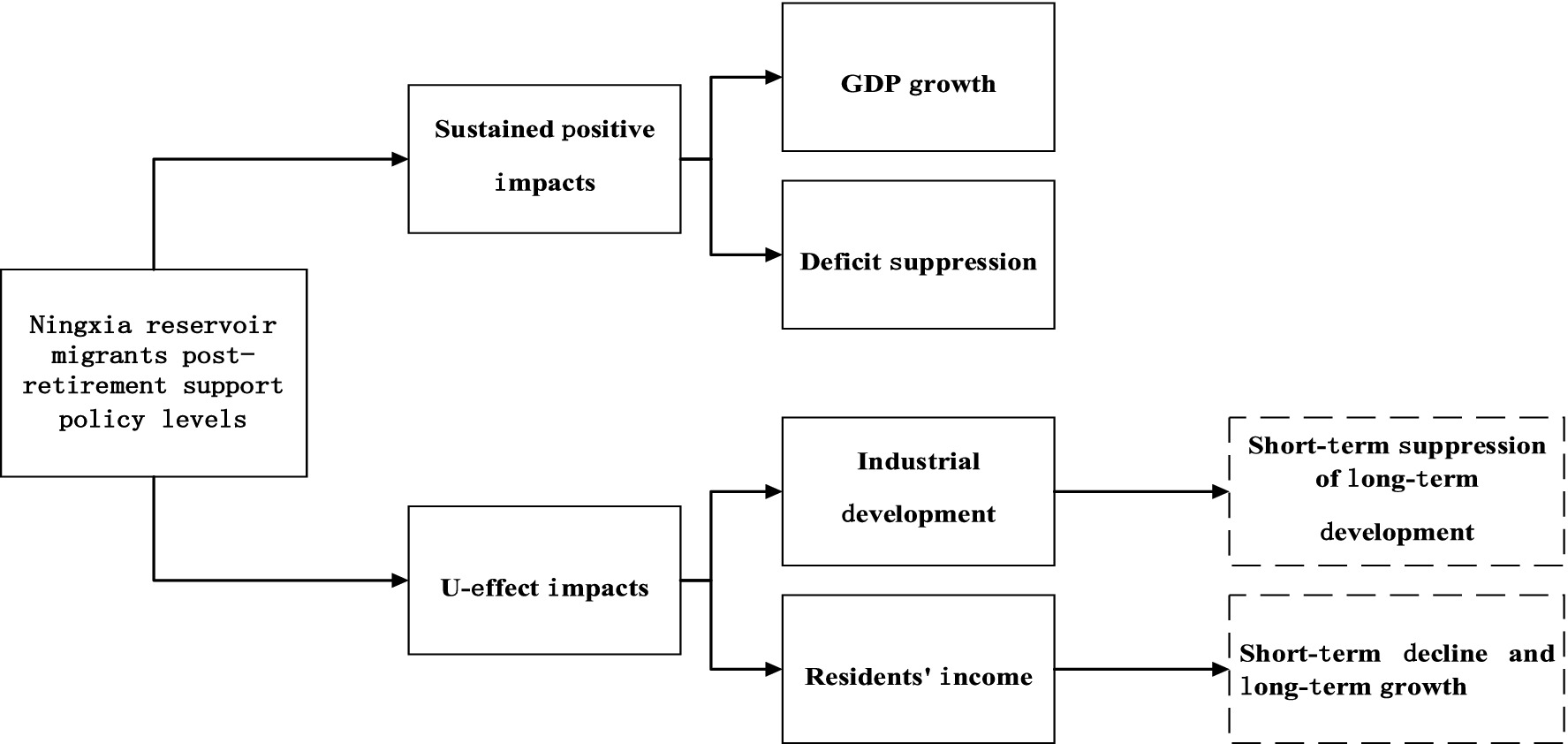
Figure 1. Influence mechanism of the effect of post-resettlement support policy in Ningxia reservoirs.
Post-resettlement support policies function as fiscal interventions aimed at particular regions and populations. These policies produce a strong multiplier effect through counter-cyclical regulation as their increased public spending (e.g., on infrastructure, regional public services, productive subsidies, industry funding) stimulates aggregate demand and promotes efficient resource use. The International Monetary Fund (IMF) reported in a 2020 study (International Monetary Fund, 2020) that public investment typically produces a higher short-term fiscal multiplier than public consumption, taxes, or transfers, particularly in economically challenged regions with weak foundations. In addition, public investment’s average fiscal multiplier reaches approximately 0.8 in the first year and grows to 1.5 over 2–5 years, demonstrating a lasting positive effect on economic growth. One reason for this effect is that spending associated with late-stage support policies directly elevates local government investment and total social expenditure, thereby significantly increasing economic demand. Besides, these policies initiate a chain reaction: expanded employment and raised enterprise investment expectations contribute to the sustained expansion of regional GDP.
Hypothesis 1: Late-stage support policies significantly increase the level of regional GDP growth.
Late-stage support policies require fiscal investment; however, their underlying economic rationale suggests they do not merely increase the fiscal deficit. Instead, these policies serve a dual purpose: cultivating regional development while also enhancing the fiscal structure. As Blanchard and Leigh (2013) noted, moderate fiscal expenditure, particularly when effective demand is low and local economies are weak, can stimulate the multiplier effect; this boosts output and employment, then driving tax growth and producing internal support for future fiscal revenues. Through mechanisms such as industrial assistance, infrastructure upgrades, and human capital investment, late-stage support policies contribute to cultivating new tax sources and broadening the tax base (OECD, 2023). Central government fiscal transfers guarantee continuous, stable funding investment, which lessens the burden on local self-financing and prevents direct increases in local government debt. Policy spending, in fiscal constraints, is expected to cultivate steady growth in regional fiscal revenues; this growth aids in easing deficit pressures over the medium to long term. Therefore, late-stage support policies are projected not merely to avoid worsening the local fiscal deficit, but potentially to stabilize or even curb its expansion in the medium-to-long run through economic stimulation and tax base enlargement.
Hypothesis 2: Late-stage support policies can significantly inhibit the development of local fiscal deficits.
Resource mismatch and production disruption often accompany the adjustment of economic structure from inefficient to efficient sectors; McMillan and Rodrik (2011) identified this process as structural transformation. During the early stage of migration, original means of production and social links face interruption. A new economic foundation is also not yet established. These conditions contribute to declining productivity and a short-term decline in income. In addition, infrastructure investment involves long construction cycles and capital sinking periods, creating a time lag before impacts on output and employment materialize (Gramlich, 1994; Duranton and Turner, 2020). The central government utilizes fiscal transfers to ensure continuous and stable investment of funds. This approach significantly lessens the pressure of local self-financing while averting direct effects on local government debt. Under the fiscal constraint mechanism, policy expenditure promotes steady growth in regional fiscal revenues. Such growth helps alleviate deficit pressure over the medium and long term. Therefore, later support policy avoids worsening the local fiscal deficit; it instead stabilizes or curbs deficit expansion in the medium and long run by boosting economic growth and broadening the tax base. Significant fiscal inputs characterize the early stages of the policy. However, the marginal effect on economic variables during this period is limited. Short-term fiscal pressures and social instability might even be exacerbated. Grossman and Krueger (1995) study indicates that forming a sustainable return to resource inputs proves challenging before the industrial structure crosses a specific size threshold. Breaching this threshold, conversely, allows the regional economy to experience “leapfrog growth.” This conclusion demonstrates high consistency with the “inhibition-accumulation-explosion” path observed at the policy’s commencement. Industrial development leads to increased employment opportunities, higher wages, and a greater participation rate in non-agricultural industries. These developments directly increase residents’ monetary and business income. The combined effect of the labor force participation rate and skill improvement motivates the continuous enhancement of the per capita income level (Zhou, 2025). Therefore, migrant resettlement regions may initially experience declines in industrial development and resident income, but this is followed by effective long-term development.
Hypothesis 3: Late support policies have a U-shaped effect of short-term inhibition and long-term enhancement on industrial development and residents’ income.
3 Materials and methods
3.1 Study area
The focus of this research is reservoir migration in China’s Ningxia Hui Autonomous Region. Located in northwestern China, the Ningxia Hui Autonomous Region exhibits a unique geography and varied climate (Figure 2). The Yellow River flows through the region, alongside numerous other rivers. Ningxia has proactively constructed large and medium reservoirs to maximize benefits such as flood control, power generation, irrigation, water supply, and ecology, while also advancing national economic and social development. Reservoir immigrants contributed significantly to these construction efforts. In total, Ningxia hosts 25 large and medium migrant-related reservoirs spread across 10 counties (cities, districts). Two large reservoirs, Qingtongxia and Shapotou, sit on the Yellow River’s mainstream. The remaining 23 medium-sized reservoirs are situated on Yellow River tributaries, including the Qingshui, Ru, Hulu, and Bitter Water Rivers.
Over 104,000 individuals comprise the population requiring late-stage support in centralized large-and medium-sized reservoirs (see Table 1 for details). Among these, the Qingtongxia Reservoir accommodated the resettlement of more than 57,000 migrants, rendering it Ningxia’s largest reservoir based on the number of resettled individuals. These reservoir projects, while stimulating regional economic development, also necessitated large-scale population relocation. Therefore, effectively addressing reservoir migration challenges, protecting the legitimate rights and interests of migrants, and promoting their sustainable development represent critical focal points in Ningxia, China, and internationally.
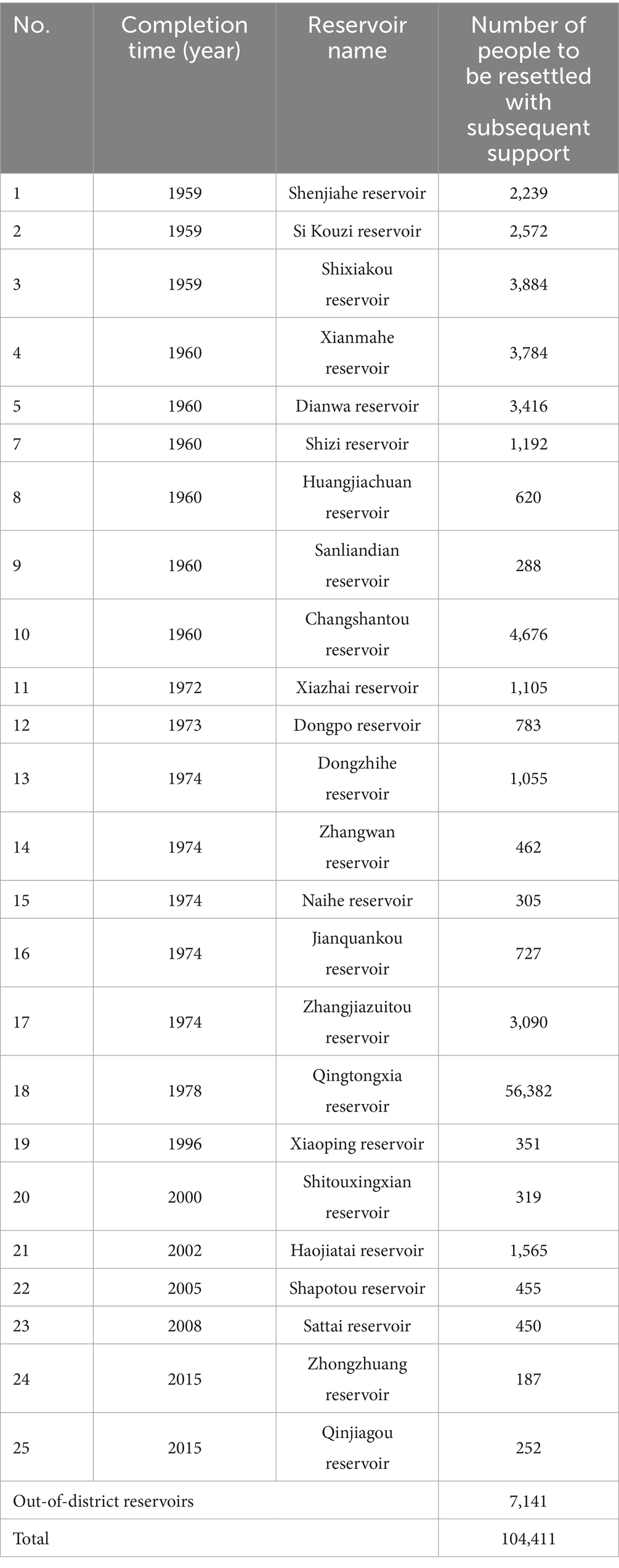
Table 1. Distribution of large and medium-sized reservoirs and population resettlement of late-stage support for migrants in Ningxia.
To manage reservoir migration affairs, Ningxia established a specialized agency, the Reservoir Migration Management Office of the Ningxia Hui Autonomous Region, in May 2008. Then, January 2018 saw the establishment of the Reservoir and Migration Management Office of the Ningxia Water Resources Department, assuming oversight for all related matters. The government implemented a policy model combining “direct subsidy funds + project support.” This system aims to ensure policy responsiveness to migrant needs and effective execution through enhancements in policy content, format, and detailed implementation planning. In addition, authorities formulated 17 local policy documents to address practical challenges including the Implementation Plan for Late-Stage Support for Migrants in Large and Medium-sized Reservoirs of the Ningxia Hui Autonomous Region [Ningxia Zhengfa (2007) No. 19] that cover areas such as transportation, drinking water, housing, water conservancy, and waste treatment in reservoir and resettlement zones. In the direct subsidy component, specific regulations such as the Regulations on the Annual Review of the Population and Funding of Direct Subsidies for the Late-Stage Support of Migrants in Large and Medium-sized Reservoirs in Ningxia detail the conditions and procedures for adjusting the subsidized population and managing funding conversions. Regarding project support, the Measures for the Management of Late-Stage Support Projects for Large and Medium-sized Reservoir Migrants in the Ningxia Hui Autonomous Region outlines specific requirements for various project management phases.
A central question for analysis is whether the series of policies developed by the Ningxia Hui Autonomous Region successfully aids reservoir migrants in poverty alleviation and wealth creation, stimulates socio-economic progress in reservoir and migrant regions, and cultivates social harmony. This study addresses this question through several steps. First, existing literature on reservoir migrants is reviewed and synthesized. Second, an evaluation index system specifically for Ningxia’s late-stage support policies is constructed. Third, a comprehensive index measuring these policies is calculated. Finally, empirical testing assesses the effect of Ningxia’s late-stage support policies on GDP, industrial development, residents’ income, and the government’s fiscal deficit.
This paper offers several marginal contributions. Its first contribution is the construction of an index system appropriate for scientifically evaluating the level of Ningxia’s late-stage support policies for reservoir migrants; measuring the comprehensive level of these policies enriches the development theory related to migrant support. Second, the research utilizes a panel regression model to empirically analyze how Ningxia’s late-stage support policy affects GDP, industrial growth, resident income, and government fiscal deficits. Third, the study offers an in-depth discussion of non-linear relationships, offering a theoretical foundation and policy recommendations for the ongoing implementation of Ningxia’s late-stage support policy.
3.2 Data sources and research areas
Employing mathematical statistics and operations research principles, this research draws upon data collected through diverse methodologies, including case studies, field investigations, sample surveys, and theoretical analysis. Extensive materials were assembled to fully understand the monitoring and evaluation objectives of post-resettlement support policies for reservoirs. These include foundational information on the resettlement processes associated with large and medium-sized reservoirs in Ningxia. Moreover, data related to policy support planning, annual fund allocation, and utilization were collected, including financial allocation documents for post-resettlement funds, detailed accounts and payment vouchers for direct subsidies and project support (financial allocation documents for post-resettlement funds, detailed accounts and payment vouchers for direct subsidies and project support), project implementation progress (including implementation plans, approvals, bidding documents, contracts, completion and acceptance related images and written materials), approvals, rosters and bank statements about direct subsidy recipients, and other relevant documents. Following iterative communication and verification with reservoir authorities, resettlement management offices, and county (cities, districts) resettlement personnel to ensure data completeness and reporting accuracy, a comprehensive collection, organization, and analysis of the annual implementation of post-resettlement support for Ningxia reservoir emigres was undertaken. This analysis was structured around post-resettlement fund implementation, direct funding subsidy distribution, and project completion and acceptance procedures.
Moreover, extensive household surveys were undertaken across 22 counties (cities, districts) and the resettlement areas administered by the Ningxia Agricultural Reclamation Group, effectively covering all emigrant households in these regions (Han et al., 2024). Annually, representative emigrant families, selected proportionally based on support mechanisms and population distribution, participated in these surveys. Data collected included household demographics, income and expenditures, infrastructural details of resettlement villages, social insurance enrollment among emigrants from rural areas surrounding large and medium-sized reservoirs, and emigrant perspectives on legal rights and satisfaction levels. Employing these data, researchers can analyze trends in per capita disposable income among emigrant families by analyzing the relative contributions of wages, business income, property income, and transfer payments. Shifts in the living conditions of these families can be evaluated by considering factors such as housing size, land ownership, educational attainment, and the quantity of durable goods they have. Finally, an analysis of primary expenditure categories in emigrant household consumption will indicate whether their spending patterns prioritize basic needs such as food and clothing or extend to the pursuit of enrichment and leisure activities.
This research’s statistical scope includes 104,400 emigrants relocated from large and medium-sized reservoirs in Ningxia. This includes individuals resettled from 25 such reservoirs in Ningxia and 18 beyond its borders. These emigrants are distributed in 137 towns, 580 administrative villages, and 13 state-owned farms in the Ningxia agricultural reclamation system across 22 counties and districts. Their distribution presents a pattern of broad dispersion with localized clusters. Relevant data was compiled according to each emigrant village’s population distribution and predetermined selection ratio, following a hierarchical structure from village to town, then to county and district. Further data was collected from the “Ningxia Statistical Yearbook (2018–2023)” and the “China Statistical Yearbook (2006–2023),” compiled by the Ningxia Hui Autonomous Region Bureau of Statistics and the Ningxia Survey Team of the National Bureau of Statistics, based on monitoring information. The sample data was processed as follows to render the sample data more representative: (1) Missing values for certain indexes were imputed utilizing linear interpolation; (2) Natural logarithms were calculated for some variables. After the above processing, the final sample consists of 90 observation values from 5 prefecture-level cities in Ningxia Hui Autonomous Region in 18 years.
3.3 Indicators of production and living development level for reservoir emigrants in Ningxia
Following consultations with senior industry experts and government regulators, we established policy investment, production level, and standard of living as primary indicators. Through extensive data collection, archival research, and consideration of Ningxia’s current socioeconomic conditions, we identified 72 secondary indicators. These included resettlement support investment, rural infrastructure, conditions for agricultural production, agricultural production and operations, characteristics of the resettled population, social security for emigrants, and emigrants’ living expenses. Each secondary indicator was divided into multiple tertiary indicators, covering 18 years of data from 2006 to 2023. Employing the entropy method, a composite of 29 underlying indicators was utilized to evaluate post-resettlement support policies for reservoir-displaced populations in Ningxia. The weighting of each indicator in the complete indicator system is presented in Table 2.
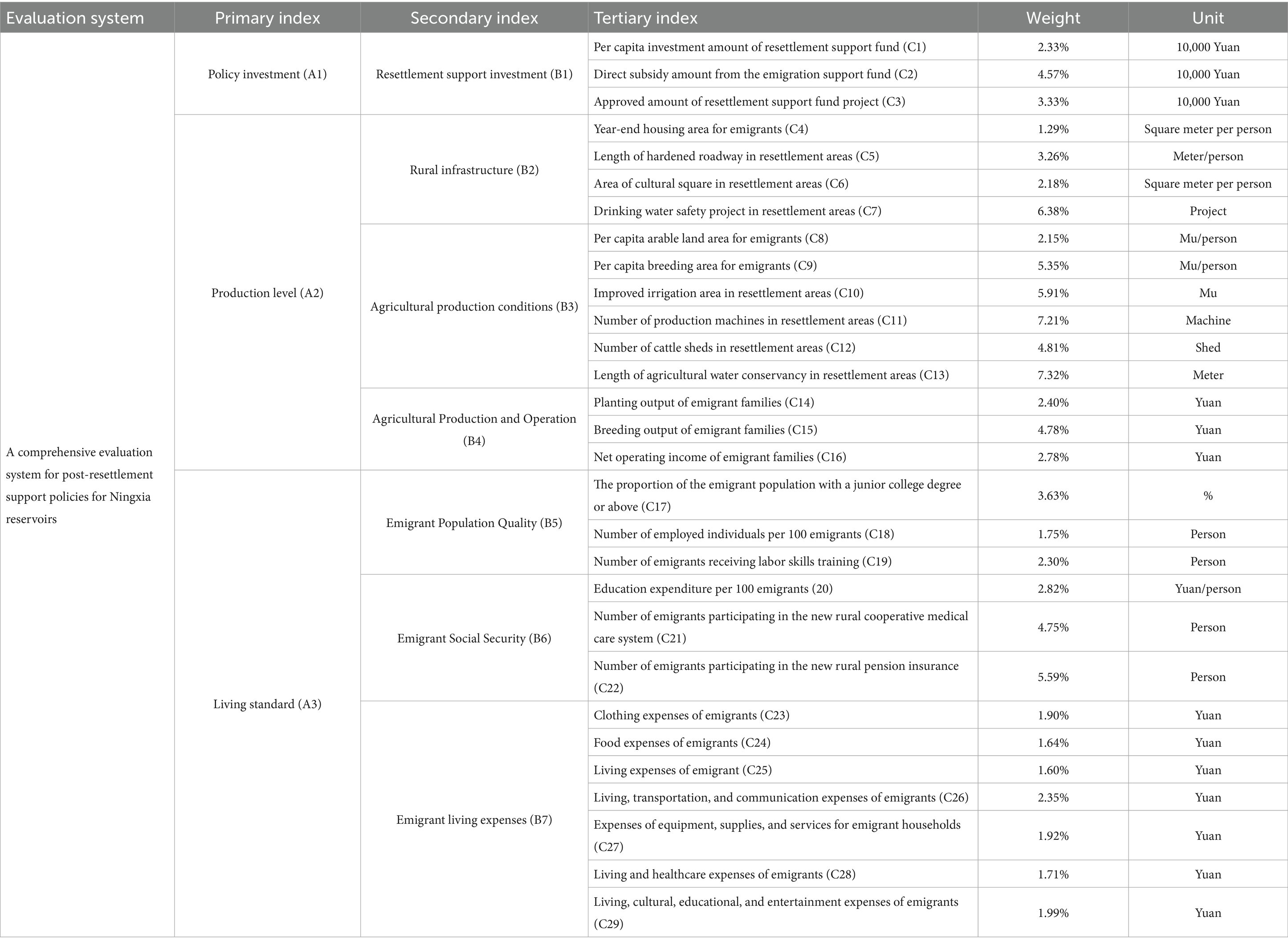
Table 2. Comprehensive evaluation indexes for post-resettlement support policies for Ningxia reservoirs.
3.4 Comprehensive index analysis of post-resettlement support policies for Ningxia reservoirs
3.4.1 Time series characteristics of the comprehensive index
Following entropy method calculations, a comprehensive index of post-resettlement support policies for reservoir-affected communities in the five prefecture-level cities of the Ningxia Hui Autonomous Region from 2006 to 2023 was generated, as presented in Table 3. Post-resettlement support policies in the Ningxia Hui Autonomous Region have demonstrated considerable effectiveness, exhibiting a generally upward trend. From 2006 to 2016, the index climbed steadily from 0.126 to 0.225. Later, from 2017 to 2023, the index followed a broadly “N”-shaped trend. Two primary factors account for the extreme values observed in this latter period. First, policy investments have seen continuous growth. The Ningxia government directly subsidized displaced individuals, covering production and living expenses. In addition, targeted project funding investments and construction projects were implemented to address important challenges faced by residents in resettlement villages. These measures effectively offset the living costs associated with displacement, thereby contributing to the rapid increase in the index. Second, the adaptability and reliance of displaced persons on these support mechanisms are noteworthy factors. Initial investments in post-resettlement support policies primarily focused on basic living security and direct subsidies. While these measures significantly improved the living standards of displaced individuals in the short term, they also carried the potential risk of cultivating dependence and reducing active investment in productive activities and employment opportunities. Such reliance arises from displaced residents’ self-sufficiency and economic self-reliance, negatively influencing long-term economic advancement and income growth in these communities and leading to a natural correction of indicators following an initial increase period.
3.4.2 Spatial characteristics of the comprehensive index
Spatial analysis of the comprehensive index for post-resettlement support policies for reservoirs in Ningxia indicates significant clustering. A central development zone, geographically focused around Wuzhong and Zhongwei, has developed and is complemented by secondary development zones to the north and south, as detailed in Table 3. From 2006 to 2023, the comprehensive index for Wuzhong and Zhongwei consistently registered high values (Figure 3), fluctuating between 0.122 and 0.534, with a mean of 0.206. This sustained performance highlights the comparative advantages enjoyed by these two cities in addressing the livelihood and economic needs of resettled populations, effectively executing policies, and solidifying their position as important drivers of progress for resettled communities in the Ningxia Hui Autonomous Region. In 2006, Shizuishan’s index value notably surpassed that of Guyuan; however, a southward shift in development momentum occurred over time. This can be primarily attributed to Guyuan’s intensified efforts in strengthening resettlement area infrastructure, increasing project funding, and thus invigorating the livelihood and economic prospects of the resettled population, which led to a qualitative leap.
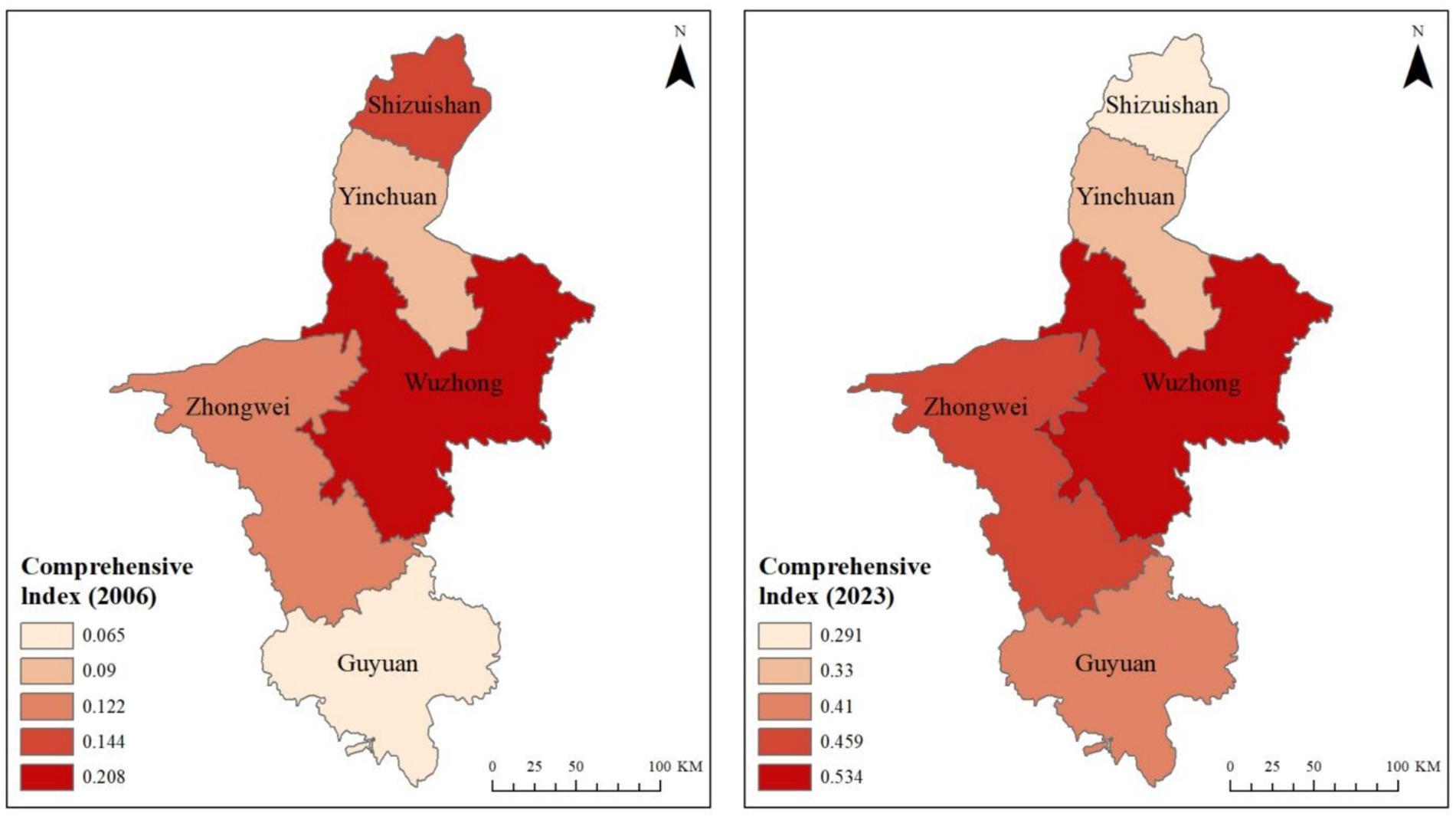
Figure 3. Spatial characteristics of the comprehensive evaluation index of post resettlement support policies for the reservoir. Color intensity in the figure corresponds to the level of the Comprehensive Index of Late-Stage Support for Reservoir Migrants’ Policies in Ningxia. Darker shades signify higher index levels, whereas lighter shades indicate lower levels.
4 Regression analysis of the effect of post-resettlement support policies for Ningxia reservoirs
4.1 Variable selection and data description
4.1.1 Variable selection
4.1.1.1 Gross domestic product
Gross Domestic Product (GDP), a key indicator utilized to measure a region’s economic development level, comprehensively reflects the overall scale of economic activity in that region and represents a key variable in evaluating the macroeconomic impact of policy interventions (Ma et al., 2020). This research selected GDP as a primary explanatory variable to analyze the effects of post-resettlement support policies implemented for reservoir areas in Ningxia on GDP growth. This analysis aims to indicate the effectiveness of these policies in stimulating regional economic development.
4.1.1.2 Per capita disposable income of reservoir emigrants
To raise the living standards of emigrants residing in Ningxia’s reservoir areas to the average level observed in the autonomous region, the Ningxia Hui Autonomous Region government has enacted diverse policy measures, achieving significantly positive results. As a direct result of these interventions, the income of emigrants has been guaranteed to a certain degree, and due to the combined efforts of governmental and societal support, the overall income level of emigrants has exhibited a continued year-over-year increase. Therefore, reservoir emigrants’ per capita disposable income (PW) was selected as a dependent variable in this analysis to study the effect of government subsidies and social assistance on emigrant income levels (Abid et al., 2023).
4.1.1.3 Industrial development level
Industrial development level (IND) is a crucial indicator of regional economic dynamism and the extent of industrial structure optimization. In this study, the “total output value of industries above designated size” acts as the core index for industrial development, allowing for an assessment of the accurate effects of post-resettlement support policies for reservoirs in Ningxia on the industrial economy. The value represents the aggregate industrial output of all qualifying regional enterprises over a defined period, reflecting the production capacity and expansion of representative large and medium-sized industrial firms in that region (Matanzima, 2022).
4.1.1.4 Fiscal deficit level
The fiscal deficit level is significantly indicated by its fiscal deficit, reflecting the equilibrium and long-term viability of governmental resource allocation and utilization. In the post-resettlement support policies for Ningxia reservoirs, direct subsidies and project approvals constitute the core expenditures of resettlement support funds. The allocation of these funds can directly influence the fiscal deficit. Therefore, to assess the fiscal deficit, the ratio of fiscal revenue to fiscal expenditure was chosen as the measurement variable, facilitating an analysis of the concrete effects of post-resettlement support policies on local fiscal conditions (Hong et al., 2023).
4.1.1.5 Control variables
Several control variables were employed to more accurately evaluate the effect of post-resettlement support policies for reservoirs in Ningxia on GDP, industrial development, resident income, and fiscal deficits. These variables account for the effect of various socioeconomic factors and enhance the robustness of the research findings. Specifically, the selected control variables include (Habich-Sobiegalla and Rousseau, 2020; He-ting et al., 2024; Chen et al., 2024; Li et al., 2024; Zhang et al., 2024; Ul Haq and Ul Haq, 2021) average employee salary, enrollment in regular higher education institutions, the number of R&D personnel, the number of patent applications, the number of museums, and total passenger transport volume.
4.2 Panel model construction
This research used the dependent variables of GDP, industrial development, resident income, and government fiscal deficits. At the same time, the level of post-resettlement support policies for reservoirs in Ningxia represented the primary explanatory variable. A panel data model was constructed based on control variables such as average employee salary, enrollment in regular higher education institutions, the number of R&D personnel, the number of patent applications, the number of museums, and total passenger transport volume. The model is as follows.
Where the dependent variable in Equation 1 represents the level of economic development in each region; the explanatory variable in Equation 2 denotes the level of industrial development in each region; the explanatory variable in Equation 3 indicates the income level of Ningxia reservoir emigrants; the explanatory variable in Equation 4 depicts the level of fiscal deficit in each region. The core explanatory variable in each equation illustrates the Ningxia reservoir resettlement policies (total amount of resettlement support funds); expresses the control variable; refers to the individual fixed effect; explains the time fixed effect; and stands for the error term.
4.3 Model evaluation and result interpretation
4.3.1 Benchmark regression results
As presented in the benchmark analysis table in Table 4, post-resettlement support policies for reservoirs in Ningxia exhibited a significant positive effect on local economic development and fiscal deficit alleviation but a negative effect on industrial development and resident income growth, respectively. Therefore, to further clarify the effect of these policies on industrial development and resident income growth, this study employed quadratic term regression to appraise the potential for a nonlinear relationship between these variables.
First, regarding the promotion of economic development, the regression results demonstrate a strong positive correlation (0.672) at the 1% significance level. This suggests that implementing post-resettlement support policies has sufficiently enhanced regional infrastructure, public services, and agricultural production conditions, establishing a robust basis for steady local economic growth. Guyuan City, situated in the core area of a concentrated special hardship region in the Ningxia Hui Autonomous Region, offers a relevant example. Following the introduction of the late-stage support policy in 2006, the city has presented continuous development, strengthened by financial aid and policy direction. Its Gross Domestic Product (GDP) climbed to 46.373 billion yuan by 2024, marking an increase of approximately 2.6 times compared to 17.79 billion yuan in 2015. Calculation based on these figures indicates an average annual GDP growth rate of approximately 11.6% from 2015 to 2024. This rate notably surpasses the national average growth over the same timeframe, thereby strengthening the policy’s contribution to regional economic expansion and lending support to research hypothesis 1 that “late-stage support policies significantly increase the level of regional GDP growth.”
Second, concerning the reduction of fiscal deficits, the regression results indicated a significant positive effect (0.328) at the 5% significance level. This indicates that these support policies have positively affected local public finances. On the one hand, these post-resettlement support policies have bettered the living conditions and production capacities of relocated populations, stabilized the social environment, allowed local governments to consolidate resources, and prevented additional fiscal strain from social instability. On the other hand, by cultivating economic development and offering industrial support, these policies have invigorated local economies, thus propelling the expansion of fiscal revenue. Accordingly, research hypothesis 2 is confirmed, suggesting that late support policies can significantly curb the expansion of local fiscal deficits.
Third, concerning industrial development, a non-significant negative result (−3.132) originated from resettlement support policies primarily directing funding and resources toward resettlement infrastructure development, agricultural assistance, and livelihood improvement. This allocation may decrease direct investment in the industrial sector and reduce capital flows into industrial enterprises. Simultaneously, these support policies may enforce more stringent environmental protection and land use regulations, potentially hindering the growth of specific heavily polluting and energy-intensive industries. This resource reallocation and these policy restrictions may significantly affect industrial expansion in the short term. Consider Yinchuan City, where the Yinchuan Metropolitan Area Urban and Rural Water Supply Project was implemented under the “Four Waters, Four Definitions.” While such initiatives have produced positive results regarding ecological environment quality improvement, they potentially create constraints for traditional industries, especially those represented by high pollution and energy consumption.
Finally, in terms of residents’ income, the regression analysis produced a significant negative coefficient (−0.048) under the condition of 10%, indicating that while post-resettlement support policies directly enhance the basic living standards of relocated individuals through subsidies and other forms of assistance, a short-term “dependency effect” may arise. This effect may lead some relocated individuals to rely on subsidies, thus reducing their active engagement in productive activities and employment. In addition, the investment of policy funds may prioritize fundamental needs, potentially resulting in underinvestment in enhancing the overall skills and long-term income-generating potential of relocated persons. Accordingly, this hinders sustained income growth for these residents.
4.3.2 Exploration of nonlinear relationship
In further nonlinear relationship analysis, as presented in Table 5, the research results exhibit that the characteristics of the post-resettlement support policies for the reservoirs in Ningxia on the income and industrial development level of residents have a characteristic that the first-order term is negative, and the second-order term is positive. This U-shaped relationship indicates that the support policies had a phased effect on economic and social development at different levels of investment. This characteristic reflects the difference in the policy implementation and the mechanism of action between the initial and mature stages. The following content will evaluate the causes and policy implications of this U-shaped relationship from residents’ income and industrial development perspectives. Research hypothesis 3 was also confirmed: late support policies demonstrate a U-shaped effect on industrial development and residents’ income, initially indicating short-term inhibition but leading to long-term enhancement.
4.3.2.1 Analysis of the U-shaped relationship between residents’ income
Regarding residents’ income, initial investments under post-resettlement support policies for Ningxia reservoirs primarily focused on ensuring basic living standards through direct financial assistance, including resettlement subsidies, basic living allowances, and infrastructure development. While these direct financial interventions significantly improved the living standards of displaced residents in the short term, the absence of robust, long-term income growth support mechanisms resulted in limited sustained improvement and potentially cultivated dependence on government subsidies. This dependence, accordingly, reduced the motivation of some residents to pursue independent livelihoods and enhance their skills. This “dependency effect” during the initial policy implementation phase created a negative first-order relationship between investment and income growth: higher initial investment correlated with slower income growth for residents.
During the intermediate and later stages of policy implementation, the focus shifted from essential subsidies to productive support measures. This included the provision of vocational training, the development of agricultural and small-scale industrial projects that are suitable for emigrants, and the optimization of start-up and employment environments. These measures facilitated improved employability and sustainable income growth among residents, gradually reducing their reliance on government subsidies. Simultaneously, policy funds were effectively reallocated as medium-and long-term investments in education and skills development. This caused enhanced skill levels among residents, improved employment prospects, and increased potential for income growth. As these support policies were further implemented and policy resources were optimized, residents’ incomes began to recover. They demonstrated a positive correlation with policy investment, thus establishing a nonlinear relationship reflected by a positive second-order term.
This U-shaped relationship demonstrates that, in the initial phases of policy implementation, subsidy investments alone are insufficient to generate sustained increases in emigrant income and may even cultivate dependency. As policies gradually shift to prioritize productive support and human capital development, emigrant income levels can achieve durable growth. Therefore, practical strategies for promoting sustained income growth among immigrants include the rational allocation of support funds, a measured decrease in direct living subsidies, and increased investment in employment opportunities, education, and skills training, key factors in promoting their sustained income growth.
4.3.2.2 Analysis of the U-shaped relationship of the industrial development level
The U-shaped relationship observed at industrial development levels also has important policy implications. Early post-resettlement support policies for reservoir areas in Ningxia centered on infrastructure development, agricultural assistance, and enhancements to residents’ quality of life. These investments exerted a “crowding out effect” on industrial sector funding, whereby limited financial resources were directed toward other sectors. Therefore, industrial enterprises, as well as small and medium-sized enterprises, encountered funding constraints. In addition, resettlement policies imposed stringent requirements on regional environmental and resource management, subjecting industrial enterprises to more significant environmental regulations. Specifically, policy restrictions effectively precluded heavily polluting and energy-intensive industries from development. These factors that resulted from policy constraints collectively contributed to a degree of industrial growth suppression during the initial phase of policy implementation, hence the negative first-order term.
As support policies progressively intensified, their effects penetrated the industrial sector, with specific projects and funds increasingly directed toward environmentally conscious and sustainable enterprises. Concurrent improvements in regional infrastructure and workforce quality resulted in a more auspicious climate for industrial expansion. In this setting, low-pollution, energy-efficient industrial firms aligning with policy objectives secured more significant support in the Ningxia reservoir areas, facilitating their growth and development. Moreover, policy support targeting agriculture and infrastructure stimulated related industrial chains, generating ancillary benefits for the industrial sector and, to a degree, propelling regional industrial advancement.
This U-shaped trend indicates that initial policy implementation negatively affected industrial development. Resources were preferentially allocated to non-industrial sectors, and the industrial sector faced constraints imposed by environmental regulations. Nevertheless, the effect of these policies on industry gradually shifted positively as policy resources were increasingly channeled toward sustainable industry, cultivating industrial development through the ripple effect of supply chains. This process highlights the effect of policy direction on industrial structure. Support policies should consider the needs of industrial sectors from the outset and enhance the adaptability and competitiveness of industrial companies through allocating funds and support measures in the middle and final stages to ensure the long-term promotion effect of support policies on the industrial sector.
4.3.2.3 The policy implications of U-shaped relationship
The U-shaped characteristic of policy implementation effects indicates that policy influence is neither linear nor singular; instead, it evolves dynamically in response to the allocation of policy resources, the adaptation of support models, and the restructuring of regional industrial structure. This phenomenon presents several key policy implications.
First, judicious resource allocation and policy equilibrium are paramount. Resources must be allocated flexibly across the various stages of policy implementation. While subsidized investment in the initial phase can facilitate short-term improvements in living conditions, a gradual transition towards productive investment is essential to reduce the risks of long-term “dependency effects” and “crowding out effects.” This transition strengthens residents’ independent development capacities and the industrial sector’s sustainable development momentum. For instance, efforts have focused on strengthening skills training and vocational education opportunities for migrants. Enterprises and vocational colleges received encouragement to organize collaborative training programs. Implementation of models such as order-based training and modern apprenticeships has also been promoted to boost migrants’ employability and career advancement prospects.
Second, support policies necessitate dynamic adjustments. The U-shaped relationship demonstrates that, in the later stages of policy implementation, purposefully channeling funds towards education, skills enhancement, and environmentally responsible industries—guided by policy adjustments and dynamic feedback mechanisms—can optimize the effectiveness of support policies. Further analysis indicates an imbalance in the current labor force distribution among the region’s migrants. Individuals with labor capacity represent about 41.4% of the total migrant population. Of these, agricultural workers constitute 17.1%, workers in the secondary industry account for 10%, and those in the tertiary industry make up 14%. Prevalent issues include the advanced average age of migrants, low levels of education, and inadequate labor s kills. Accordingly, policymakers should regularly evaluate policy effectiveness, tell apart stage-specific differences in influence, and adapt the support direction for different industries and demographic groups.
Third, comprehensive support for regional industrial chains is crucial. The empirical findings, as evidenced by the U-shaped relationship, emphasize that the effectiveness of resettlement support policies should not be confined to short-term livelihood security. Instead, it is necessary to guide the optimization of industrial chains and the development of human capital to achieve comprehensive connection among different types of industrial, agricultural, and service sectors in the region, thereby cultivating a robust and sustainable development system. The development of characteristic industrial projects is encouraged in districts. Key projects, therefore, motivate regional development. For instance, Hongsibao District established the Bairuiyuan wolfberry planting base. This district also carried out the development of characteristic agricultural projects. In addition, active guidance toward optimizing the industrial chain has created a large number of employment opportunities for immigrants. The development of e-commerce, new retailing, and other new business forms was also promoted by these efforts.
Fourth, policy sustainability must be reinforced. Policies should prioritize long-term development by integrating short-term livelihood security with long-term income growth and industrial development objectives. Through optimized fund allocation, policies can balance diverse areas requiring support, promote the concurrent advancement of emigrant incomes and industrial development levels, and contribute to the overall sustainable development of the regional economy.
4.3.3 Robustness test
To ensure the robustness of the regression results, three methods—system GMM, explanatory variable substitution, and sample interval adjustment—were employed to appraise the effect of post-resettlement support policies for reservoirs in Ningxia. Moreover, this research’s central objective is to evaluate these policies’ overall impact on Ningxia’s GDP, industrial development, resident income, and fiscal deficit. Standard robustness and endogeneity tests (e.g., system GMM, variable substitution, sample interval adjustment) were conducted utilizing linear models to isolate the primary effects of these policies, verifying the robustness of policy effects on the key indicators. Introducing nonlinear relationships allows for further exploration of the characteristics of specific variables; however, it does not constitute the core robustness findings of this research. Therefore, additional nonlinear robustness and endogeneity tests were not performed on industrial development and resident income levels.
4.3.3.1 Robustness testing of substitute variables
In this research, the methodology utilized to construct the post-resettlement support policy index for Ningxia reservoirs directly affects the reliability of the policy effect analysis. The employed entropy weighting method objectively reflects the distributional differences among the indicators. However, results from different weighting methods may influence the policy effect analysis. Accordingly, recalculating the policy index utilizing principal component analysis (PCA) can offer a different weighting method and verify the original conclusions’ robustness. The regression results in Table 6 align with the aforementioned results, confirming that the robustness test was satisfied.
4.3.3.2 Change regression method - system GMM regression
This research employed multiple statistical tests to verify the robustness of the system GMM model, as detailed in Table 7. First, the presence of a significant AR (1) term and an insignificant AR (2) term indicates the absence of second-order autocorrelation in the error term, thereby confirming that the setting of the model was robust. Second, the Sargan test results, with p-values exceeding 0.05 for both models, demonstrate that no overidentification issues exist in the models, supporting the appropriateness of the selected instrumental variables. Finally, the significance of the variable coefficients indicates a consistently positive and significant result of the core variable (Policy) across both models. This result suggests that support policies have a stable and positive effect on economic growth and fiscal deficits, even under different regression settings.
4.3.3.3 Change the sample range - eliminate the effect of COVID-19
Accordingly, the outbreak of the COVID-19 pandemic in 2020 created a massive change in the global and regional economies. It led to key fluctuations in key economic indicators such as GDP, industrial development, and fiscal deficits. Throughout the pandemic, governments implemented a range of short-term emergency policies and fiscal stimulus measures, which disrupted established economic mode to a certain degree. If the epidemic’s effect is included in the analysis, it may distort the Evaluation of the intended policy results.
Excluding the epidemic’s effect helps avoid the interference of anomalous fluctuations in policy and economic indicators during this unique period on the robustness test results, thereby allowing for a more accurate assessment of the long-term effects of post-resettlement support policies on Ningxia reservoirs. The primary aim of robustness testing is to determine the stability of policy effects across various specified conditions. The transient effect of the COVID-19 epidemic is neither sustained nor a relevant factor in the intended policy implementation process. Therefore, removing epidemic-related data points is essential for evaluating the model under more representative economic conditions, ensuring the findings display more remarkable universality and generalizability. By constraining the sample period to 2006–2020, the observed policy effect better reflects the economic development trend before the epidemic. It enhances the applicability of the study’s conclusions to future periods or other non-epidemic periods. As indicated by the regression results presented in Table 8, the directional effect of the resettlement support policy on GDP, industrial development, residents’ income, and the fiscal deficit remains unchanged across these adjusted sample intervals, confirming the robustness of the findings.
4.3.3.4 Endogeneity test
This research demonstrated a two-stage least squares method (2SLS) to create an effect on the endogeneity of the policy variable “Policy,” as detailed in Table 9. The instrumental variables connect the first-order lag of the approved amount and the direct subsidy amount from the Central Government’s Reservoir Resettlement Support Fund Project. This selection is justified on two grounds. First, these lagged values strongly connect with the current “Policy” variable. Prior investment of resettlement support funds directly affects the present policy level, thus establishing the necessary correlation between the instrumental and the different endogenous variables. Second, these lagged instrumental variables are unaffected by the current error term, satisfying the homogeneity requirement for instrumental variables. Since the lagged approved and direct payment amounts are independent of the error term, they remain unaffected by the current policy environment and random disturbances, rendering them suitable instrumental variables.
The instrumental variable selection and model identification test results demonstrate the robustness of the model. First, the under-identification test (Kleiberen Paap rk LM statistic was 7.870, p = 0.0196) indicated a significant relationship between the instrumental and endogenous variables “Policy.” This suggests that the instrumental variables exhibit adequate explanatory power to account for changes in the endogenous variable. Second, the weak identification test yielded Cragg-Donald Wald F and Kleibergen-Paap rk Wald F statistics of 5.796 and 4.528, respectively. While these values decline below Stock-Yogo’s 10% maximal IV bias critical value (19.93), they satisfy the criteria for instrumental variable validity in a more permissive threshold range of 15–25% maximal IV bias. This indicates a weak instrument risk, which remains in acceptable bounds at a bias level exceeding 15%. Moreover, the Hansen J overidentification test (statistic 0.989, p = 0.3200) returned non-significant results, implying that the chosen instrumental variables are uncorrelated with the error term, consistent with the homogeneity assumption. These results further substantiate the appropriateness of the instrumental variables, confirming that the model is free from biases arising from improper instrumental variable selection. In conclusion, the instrumental variable configuration utilized in this study is well-justified, satisfying both the identification and homogeneity tests. This convincingly supports the model’s robustness and the resulting estimates’ trustworthiness.
5 Conclusion and ways forwards
This paper constructs a comprehensive evaluation system for Ningxia’s late-stage reservoir migrant support policy (2006–2023), according to a large-scale field research project. The system’s construction also drew upon existing research concerning support policies for reservoir migrants in the Ningxia Hui Autonomous Region. Calculation of the comprehensive evaluation level was achieved utilizing the entropy value method. A two-way fixed panel model was employed. Its purpose was to study the effect of Ningxia’s late-stage support policy for reservoir migrants on several key indicators: GDP, industrial development, residents’ income, and the government fiscal deficit. The study’s findings indicated that Ningxia’s late-stage support policy for reservoir immigrants significantly promotes local economic development and alleviates the fiscal deficit; whereas, an inhibitory effect was observed on industrial development and the growth of residents’ income. Nonlinear relationships were further discussed, indicating specific characteristics in the policy’s effects on residents’ income and industrial development levels. Both indicators exhibited a negative primary term and a positive secondary term. This pattern indicates the existence of a U-shaped relationship connecting the late-stage support policy with residents’ income and industrial development levels. To verify the study’s robustness and address potential endogeneity, several validation methods were applied. The research conclusions remained consistent even after replacing variables, changing the regression method (systematic GMM regression), changing the sample intervals (excluding the effect of the Xin Guan epidemic), and the two-stage least squares (2SLS) method for validation.
Support policy for reservoir migrants should be long-term which necessitates regular evaluation of policy effectiveness. Flexible adjustment of the support’s direction, based on effectiveness differences at various stages, is also critical. The future focus of migrant support policy maintains an emphasis on basic livelihood protection and infrastructure construction for migrants. However, a gradual tilt can occur towards productive support and environmentally friendly, sustainable development-oriented industries. Through such policy support, the aim is to promote the transformation and upgrading of industries in migrant areas. The improvement of the overall competitiveness of the regional economy is the objective of this industrial enhancement. While this thesis achieved its originally expected research objectives, certain limitations remain. Considering the research sample, an analysis of migrants’ policy responses from diverse backgrounds (e.g., age, gender, occupation) was not conducted. Therefore, the conclusions drawn lack a more direct level of exploration. Future research should expand the study’s scope, incorporating more immigrant populations to facilitate in-depth comparative studies. Concerning research variables, other factors potentially affecting the results could also be considered, despite the use of controls such as average employee wages and higher education enrollment. Future in-depth explorations should focus on issues such as the job market and education quality; therefore, referring to China’s rich immigration policies would be beneficial for these explorations.
Data availability statement
The raw data supporting the conclusions of this article will be made available by the authors, without undue reservation.
Author contributions
LW: Writing – original draft, Writing – review & editing, Investigation, Methodology. YL: Conceptualization, Data curation, Formal analysis, Investigation, Project administration, Software, Writing – review & editing. TL: Data curation, Investigation, Validation, Visualization, Writing – review & editing.
Funding
The author(s) declare that financial support was received for the research and/or publication of this article. Central Reservoir Resettlement Support Fund (2130321), Reservoir and Resettlement Management Office of Ningxia Water Resources Department, Yinchuan.
Conflict of interest
The authors declare that the research was conducted in the absence of any commercial or financial relationships that could be construed as a potential conflict of interest.
Generative AI statement
The author(s) declare that no Gen AI was used in the creation of this manuscript.
Publisher’s note
All claims expressed in this article are solely those of the authors and do not necessarily represent those of their affiliated organizations, or those of the publisher, the editors and the reviewers. Any product that may be evaluated in this article, or claim that may be made by its manufacturer, is not guaranteed or endorsed by the publisher.
References
Abdullah, A. N. M., and Rahman, S. (2021). Social impacts of a mega-dam project as perceived by local, resettled and displaced communities: a Merowe dam, Sudan case study. Economies 9:140. doi: 10.3390/economies9040140
Abid, S., Shi, G., Hussain, A., and Rauf, A. (2023). Fostering well-being in resettled communities: cultivating cultural resilience and sustainable development in resettlement caused by ghazi Barotha hydropower project, Pakistan. Water 15:3973. doi: 10.3390/w15223973
Agnes, R. D., Solle, M. S., Said, A., and Fujikura, R. (2009). Effects of construction of the Bili-Bili dam (Indonesia) on living conditions of former residents and their patterns of resettlement and return. Int. J. Water Resour. Dev. 25, 467–477. doi: 10.1080/07900620902965186
Blanchard, O., and Leigh, D. (2013). Growth forecast errors and fiscal multipliers. Am. Econ. Rev. 103, 117–120. doi: 10.1257/aer.103.3.117
Borbely, D., and McKenzie, R. (2024). Forced migration and local economic development: Evidence from postwar Hungary. J. Dev. Econ. 171:103355. doi: 10.1016/j.jdeveco.2024.103355
Cernea, M. M. (1995). Understanding and preventing impoverishment from displacement: reflections on the state of knowledge. J. Refug. Stud. 8, 245–264. doi: 10.1093/jrs/8.3.245
Cernea, M. M. (1999). Why economic analysis is essential to resettlement: a sociologist’s view. Econ. Polit. Wkly. 34, 2149–2158.
Cernea, M. M. (2007). Financing for development: benefit-sharing mechanisms in population resettlement. Econ. Polit. Wkly. 42, 1033–1046.
Cernea, M. M. (2008). Compensation and benefit sharing: why resettlement policies and practices must be reformed. Water Sci. Eng. 1, 89–120. doi: 10.1016/S1674-2370(15)30021-1
Cernea, M. M., and McDowell, C. (2000). Risks and reconstruction: Experiences of resettlers and refugees. London: World Bank Publications.
Chen, S., Yu, D., Lei, M., Sun, J., and Wang, X. (2024). Evaluation on the willingness of migrants and native farmers to transfer farmland in resettlement areas and their coupled coordination relationships: perspectives for environmental and social sustainability. Front. Environ. Sci. 12:1297682. doi: 10.3389/fenvs.2024.1297682
Downing, T. E. (2002). Avoiding new poverty: Mining-induced displacement and resettlement. London: International Institute for Environment and Development.
Downing, T. E., Shi, G., Zaman, M., and Garcia-Downing, C. (2021). Improving post-relocation support for people resettled by infrastructure development introduction. Impact Assess. Proj. Apprais. 39, 357–365. doi: 10.1080/14615517.2021.1980277
Duranton, G., and Turner, M. A. (2020). Urban form and driving: evidence from US cities. Rev. Econ. Stat. 102, 1144–1157.
Fox, J., and Brown, L. D. (1998). The struggle for accountability: The World Bank, NGOs, and grassroots movements. London: MIT Press.
Grossman, G. M., and Krueger, A. B. (1995). Economic growth and the environment. Q. J. Econ. 110, 353–377. doi: 10.2307/2118443
Gu, A., and Shi, G. (2019). Research on the social stratification of involuntary migrants--take the LRC migrant village in the Danjiangkou reservoir area as an example. J. Nanjing Agric. Univ. 19, 91–159. doi: 10.19714/j.cnki.1671-7465.2019.0027
Guoqing, S. (2018). Comparing China’s and the World Bank’s resettlement policies over time: the ascent of the ‘resettlement with development’ paradigm challenging the prevailing paradigm of displacement and resettlement. Resettlement in Asian countries. London: Routledge, 143–161.
Habich-Sobiegalla, S., and Rousseau, J. F. (2020). Responsibility to choose: governmentality in China’s participatory dam resettlement processes. World Dev. 135:105090. doi: 10.1016/j.worlddev.2020.105090
Han, Q., Guo, Z., Kumar, R., and Kumar, A. (2024). An empirical approach for enhancing farmers' concentrated residence strategies: a case study in Jiangsu Province, China. Ecol. Indic. 158:111361. doi: 10.1016/j.ecolind.2023.111361
Han, Q., Kumar, R., and Kumar, A. (2024). Climate change and human migration: perspectives for environmentally sustainable societies. J. Geochem. Explor. 256:107352. doi: 10.1016/j.gexplo.2023.107352
He-ting, D., Gui-sheng, X. U., and Peng-fei, Y. (2024). Research on the index system and empirical evaluation of production and living standards of large and medium-sized reservoir resettlers. China Rural Water Hydropower.
Hong, X., Chen, S., and Sun, J. (2023). Role of non-governmental organizations in post-relocation support of reservoir migrations in China: a just transition perspective. Front. Environ. Sci. 11:1339953. doi: 10.3389/fenvs.2023.1339953
Huang, L., Huang, J., and Wang, W. (2018). The sustainable development assessment of reservoir resettlement based on a BP neural network. Int. J. Environ. Res. Public Health 15:146. doi: 10.3390/ijerph15010146
International Monetary Fund (2020). Fiscal monitor: Public investment for the recovery. Washington, DC: International Monetary Fund.
Kondo, K. (2022). Ex ante evaluation of migration subsidy: Evidence from Japan (RIETI Policy Discussion Paper Series 22-P-031). Research Institute of Economy, Trade and Industry (RIETI). Available online at: https://www.rieti.go.jp/en/publications/summary/22090010.html
Koranteng, R. T. B., and Shi, G. (2018). Using informal institutions to address resettlement issues–the case of Ghana dams dialogue. J. Sustain. Dev. 11, 27–52. doi: 10.5539/jsd.v11n4p27
Kumar, A., and Sharma, M. P. (2015). Assessment of risk of GHG emissions from Tehri hydropower reservoir, India. Hum. Ecol. Risk. Assess. 22, 71–85. doi: 10.1080/10807039.2015.1055708
Kumar, A., and Sharma, M. P. (2016). A modeling approach to assess the greenhouse gas risk in Koteshwar hydropower reservoir, India. Hum. Ecol. Risk. Assess. 22, 1651–1664. doi: 10.1080/10807039.2016.1209077
Li, R. (2018). Research on agricultural land investment behavior of farmers in reservoir resettlement areas [Doctoral dissertation]. Wuhan: Huazhong Agricultural University.
Li, Q., Xu, Y., Zhao, X., Xie, J., Jiao, T., and Su, Z. (2024). Research on the livelihood capital and livelihood strategies of resettlement in China’s south-to-north water diversion middle line project. Front. Sustain. Food Syst. 8:1396705. doi: 10.3389/fsufs.2024.1396705
Liang, B., Shi, G., Sun, Z., Wang, Y., Zhang, B., Xu, Y., et al. (2023). Impact assessment of the implementation effect of the post-relocation support policies of rural reservoir resettlers’ livelihoods in energy transition. Water 15:3129. doi: 10.3390/w15173129
Ma, Y., Fan, H., Li, Y., and Zhang, M. (2020). Rehabilitating livelihoods of relocated people affected by the Nuozhadu dam on the upper Lancang-Mekong River. Geogr. J. 186, 59–72. doi: 10.1111/geoj.12324
Matanzima, J. (2022). ‘We were displaced several times since 1956’: the Tonga–Goba involuntary resettlement experiences at the Kariba dam. Water Int. 47, 1249–1266. doi: 10.1080/02508060.2022.2085851
Mathura, E. (2020). Dam-induced displacement and resettlement: reflections from Tokwe-Mukorsi flood disaster, Zimbabwe. Int. J. Disaster Risk Reduct. 44:101407. doi: 10.1016/j.ijdrr.2019.101407
McMillan, M. S., and Rodrik, D. (2011). Globalization, structural change, and productivity growth (NBER working paper no. 17143). Cambridge, MA: National Bureau of Economic Research.
Oliver-Smith, A. (2010). Defying displacement: Grassroots resistance and the critique of development. Austin, TX: University of Texas Press.
Park, S. (2010). “The World Bank's global safeguard policy norm” in Owning, development: Creating policy norms in the IMF and the World Bank. eds. S. Park and A. Vetterlein (Cambridge: Cambridge University Press), 181–203.
Peng, S., Shi, G., and Zhang, R. (2021). Social stability risk assessment: status, trends, and prospects—a land acquisition and resettlement case in the hydropower sector. Impact Assess. Proj. Apprais. 39, 379–395. doi: 10.1080/14615517.2019.1706386
Price, S. (2009). Prologue: victims or partners? The social perspective in development-induced displacement and resettlement. Asia Pac. J. Anthropol. 10, 266–282. doi: 10.1080/14442210903305821
Raihan, F., and Milon, M. (2021). Livelihood vulnerability assessments and adaptation strategies to climate change: a case study in Tanguar haor, Sylhet. J. Water Clim. Chang. 12, 3448–3463. doi: 10.2166/wcc.2021.047
Reddy, A. A. (2018). Involuntary resettlement as an opportunity for development: the case of urban resettlers of the new Tehri town. J. Land Rural Stud. 6, 145–169. doi: 10.1177/2321024918766590
Scudder, T., and Colson, E. (1982). From welfare to development: a conceptual framework for analyzing dislocated people. A. Hansen and A. Oliver-Smith (A. Hansen and A. Oliver-Smith (Eds.) Involuntary migration and resettlement: The problems and responses of dislocated people (267–288). Boulder, CO: Westview Press.
Shaik, S. S. (2009). The collage of SN2 reactivity patterns: a state correlation diagram model. Prog. Phys. Org. Chem. 15:197.
Shi, G., Yu, F., and Wang, C. (2021). “Social assessment and resettlement policies and practice in China: contributions by Michael m Cernea to development in China” in Social development in the World Bank. ed. R. S. Parker (Cham: Springer), 329–344.
Ul Haq, I., and Ul Haq, I. (2021). “Resettlement in hydropower projects in Pakistan: lessons from case studies and way forward” in Resettlement in Asian countries. eds. M. Zaman, R. Nair, and S. Guoqing (London: Routledge), 135–149.
van Wicklin, W. (2001). Involuntary resettlement: Comparative perspectives. 1st Edn. London: Routledge.
Xu, Y., Shi, G., and Dong, Y. (2022). Effects of the post-relocation support policy on livelihood capital of the reservoir resettlers and its implications—a study in Wujiang sub-stream of Yangtze River of China. Sustain. For. 14:2488. doi: 10.3390/su14052488
Yeboah, A. S., Baah-Ennumh, T. Y., and Okumah, M. (2022). Understanding the economic, socio-cultural, and environmental impacts of resettlement projects. Afr. Geogr. Rev. 41, 71–92. doi: 10.1080/19376812.2020.1850299
Zaman, M., Khatun, H., and Islam, S. (2021). “Development-induced displacement and resettlement in Bangladesh: the new land law and resettlement guidelines” in Resettlement in Asian countries. eds. M. Zaman, R. Nair, and S. Guoqing (London: Routledge), 19–28.
Zhang, H., Cao, Z., Zhou, K., and Ji, Y. (2024). Research on the relationship between social capital and sustainable livelihood: evidence from reservoir migrants in the G autonomous prefecture, China. Front. Environ. Sci. 11:1358386. doi: 10.3389/fenvs.2023.1358386
Zhao, Y., and Pang, J. (2024). Impact of migrant relocation in ecological reserve on the vulnerability of low-income farm households. J. Chongqing Gongshang Univ.
Keywords: reservoir resettlement, post-resettlement support policies, economic development, nonlinear relationship, system GMM
Citation: Wang L, Lu Y and Li T (2025) Effect of post-resettlement support policies for Ningxia reservoirs. Front. Sustain. Cities. 7:1560227. doi: 10.3389/frsc.2025.1560227
Edited by:
A. Amarender Reddy, National Institute of Agricultural Extension Management (MANAGE), IndiaReviewed by:
Amit Kumar, Nanjing University of Information Science and Technology, ChinaJiquan Peng, Jiangxi University of Finance and Economics, China
Ishwar Joshi, Utah State University, United States
Arun Reddy Anugu, Indian Institute of Technology Gandhinagar, India
Copyright © 2025 Wang, Lu and Li. This is an open-access article distributed under the terms of the Creative Commons Attribution License (CC BY). The use, distribution or reproduction in other forums is permitted, provided the original author(s) and the copyright owner(s) are credited and that the original publication in this journal is cited, in accordance with accepted academic practice. No use, distribution or reproduction is permitted which does not comply with these terms.
*Correspondence: Le Wang, d2FuZ2xlNzUzNDAwQDEyNi5jb20=
 Le Wang
Le Wang Yang Lu
Yang Lu